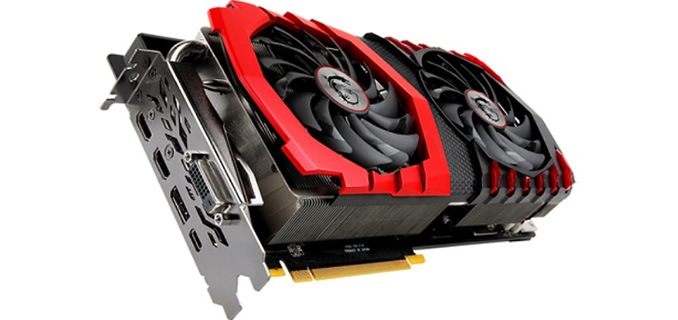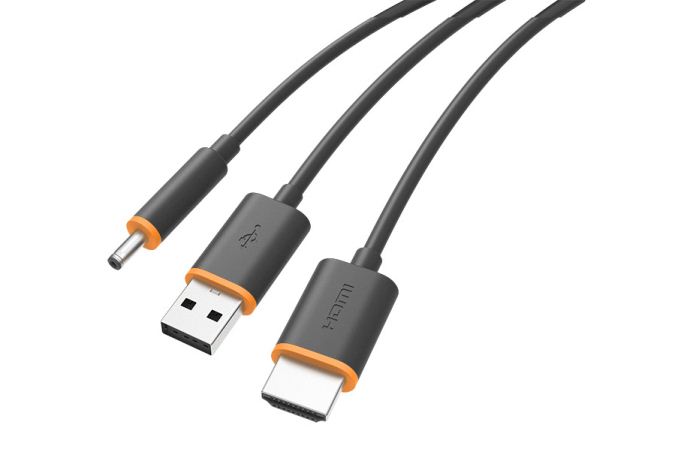VirtualLink USB-C Alt Mode Announced: Standardized Connector for VR Headsets
by Ryan Smith on July 17, 2018 9:30 AM EST
While PC VR headsets are fun, no one has especially enjoyed the number of cables required to hook one up. With separate video, power, and data cables, the end result has been that manufacturers have used somewhat unwieldy cables or breakout boxes. However as part of the generalized push towards the second generation of VR headsets, a new industry consortium is coming together today to reduce the requirements to a single cable. Backed by NVIDIA, AMD, Oculus, Valve, and Microsoft, the new VirtualLink standard is a USB Type-C alternate mode that will be able to supply all of the necessary power, video information, and data over a single Type-C cable and connector.
Today’s announcement from the group is essentially a call for participation, announcing the group’s existence and inviting others to get involved ahead of the VirtualLink 1.0 specification. So the consortium and its members are broadly talking about the standard itself, but are not saying anything about products that may implement it. And indeed as of Monday evening as I’m writing up this article, the VirtualLink consortium’s website still isn’t up.
In any case, the rationale for creating a standardized connector is pretty straightforward. A clunky multi-port cable is okay for first-generation early adopter products, but if the consortium members want to push VR adoption, then the setup process needs to be easier to reach the masses. This includes not only reducing the cable down to a single port, but also making these headsets easier to use with laptops, where HDMI ports are uncommon and DisplayPort is primarily picking up penetration through the popularity of the associated USB-C alternate mode. So a standard for a single cable, using the smallest yet most compatible port choice, is going to be the best way forward.
What this amounts to is that the standard is being implemented as a USB Type-C alternate mode. USB-C is the natural choice here, as the wider industry is already consolidating around the port for external connectivity, and the port + cable is designed to carry multiple lanes of data along with significant amounts of power. In fact I was a bit surprised that this required a new alternate mode at all – we already have the DisplayPort alternate mode – but after checking with the consortium, there is a good reason for this.
The official VirtualLink standard calls for 6 lanes of high speed data – 4 DisplayPort HBR 3 channels for video, and a single USB 3.1 Gen 2 channel (2 lanes) for data – along with a mandatory 15W of power. And while you can combine the DisplayPort alt mode with those power requirements, the lynchpin is 4 lanes of video plus the USB 3.1 Gen 2 data channel. By the standard, DisplayPort alt mode replaces all of the USB 3.1 data channels when using a full 4 lane configuration, leaving only the much slower USB 2.0 baseline channels available.
| USB Type-C Alternate Modes | ||||||
| VirtualLink | DisplayPort (4 Lanes) |
DisplayPort (2 Lanes) |
Base USB-C | |||
| Video Bandwidth (Raw) | 32.4Gbps | 32.4Gbps | 16.2Gbps | N/A | ||
| USB 3.x Data Bandwidth | 10Gbps | N/A | 10Gbps | 10Gbps + 10Gbps | ||
| High Speed Lane Pairs | 6 | 4 | ||||
| Max Power | Mandatory: 15W Optional: 27W |
Optional: Up To 100W | ||||
As it turns out, tucked away in version 1.3 of the USB Type-C cable specification released last year, the USB-IF has made some small but important changes to what alternate modes are allowed to do, which in turn means that new standards are needed to take advantage of these changes. In short, for direct connect devices – that is, devices connected directly to a USB-C port and not going through a hub or other extender/repeater – those devices are now allowed to reconfigure the 4 USB 2.0 pins (A6/A7/B6/B7) after the device handshake. So for the VirtualLink standard, this means that VR headsets can tap these additional 4 pins, giving them the extra flexibility they need in order to simultaneously meet the video, power, and data requirements of a VR headset.

VirtualLink Receptacle Pin Configuration (Color Coded)
Diving a bit deeper, what this essentially means is that the 4 USB 2.0 pins have been turned into another pair of high-speed differential lanes, giving compliant USB-C connectors 6 high-speed lanes overall. Normally these 4 pins are implemented in a USB-C cable as simple unshielded twisted pairs, which is sufficient for USB 2.0 data. However high-speed operation requires shielded differential pairs, which is not part of the base cable specification. But in the case of direct connect devices, they come with their own cable, meaning the usual cable rules can be thrown out the window and vendors can specifically use higher quality cabling to get away with high speed data on these pins.
The net result of all of this is that the VirtualLink standard is a rather forward-looking standard in terms of capabilities. 4 lanes of HBR3 video data alone is equivalent to a DisplayPort 1.4 connector, which is to say that it offers enough video bandwidth for 4K @ 120Hz with 8bpc color. This is more than double the bandwidth afforded to the Rift and Vive via their HDMI 1.3 connectors. I also find it interesting that after favoring HDMI for the first-generation products, this change means the industry is shifting to DisplayPort. DisplayPort of course is royalty free, among its other advantages, however its packet-based data transfer paradigm is very different than HDMI’s classic pixel-based TMDS system, which is an important distinction when you’re talking about how to best fight latency.
Meanwhile a full USB 3.1 Gen 2 data connection means there’s 10Gbps of bandwidth for data transfers between HMDs and the host computer, which right now at least is bordering on overkill. Though I’m very curious what the consortium is doing here (if they’re doing anything at all) to combat the fact that USB 3.1 Gen 2 data is normally only rated to run over 1 meter cables due to faster signal attenuation, which is a rather short cable length for a VR headset and the room scale experiences the vendors are pushing. Otherwise the power standard is a bit more complex; the standard supports up to 27W of power, but only 15W of that is mandatory. Of course the current Vive and Rift consume a fraction of that, but they had to be designed around the limitations of a USB 3.0 Type-A connector to begin with. As headsets become increasingly powerful in their own right – especially with inside-out tracking – a greater power budget will undoubtedly come in handy. (As an aside, the consortium’s announcement doesn’t list voltages here, but 15W & 27W are almost certainly 5V & 9V @ 3A respectively, a common mid-power point for USB-C devices.)
Unfortunately this is the limit to what we know about the specification at this time. As mentioned previously, the consortium’s members aren’t talking about specific implementations quite yet, such as which types of devices the members would like to put VirtualLink-capable USB-C ports on. For desktop PCs the logical choice is video cards – especially if USB-C eventually replaces the DisplayPort connector outright – which is something we’ve seen manufacturers toy with, but not actually reach shipping products. This would also be consistent with the consortium’s goals of making VirtualLink a low-latency port (owing to the comfort requirements for VR).

MSI's Unreleased USB-C Equipped GTX 1080 Ti
The flip side to all of this is that AMD, NVIDIA, and their board partners would need to start implementing either USB 3.1 controllers or USB 3.1 headers on their cards, in order to supply the necessary data connectivity. Which is not too difficult to do, but it’s yet another feature that video cards would need to support. And without going too far down the rabbit hole here, where this ultimately could lead to is that we’re about to see a major shift in the kinds of ports available on video cards, especially if most video cards need to be VirtualLink capable to maximize the number of systems that can be used with VR headsets.
Conversely, laptops should be relatively easy due to their highly integrated nature. USB-C ports are already common there, so it’s just a matter of adding another USB-C alternate mode. However it does call into question whether the consortium will be able to convince laptop manufacturers to adopt the alt mode for large swaths of their product lines (similar to the DP alt mode today), or if it will only be found on high-end gamer-focused laptops.
In any case, this should be a welcome development for the industry as a whole. While VR hasn’t proven to be as immensely popular with consumers as some vendors had hoped, VR headset adoption has shown solid growth and spurred plenty of system upgrades to drive the data-hungry headsets. So anything that further simplifies the process is going to be a welcome move for consumers and hardware vendors alike.
Source: VirtualLink












50 Comments
View All Comments
lightningz71 - Tuesday, July 17, 2018 - link
With respect to the cable length requirement on USB 3.1 gen2, that can be overcome through higher quality cables from the manufacturers combined with the alternate mode supporting a reduced data rate. Combining those two things can more than double the length that you can run a stable data connection through. Those cables are NOT going to be cheap though. While, in my experience, USB-C connectors seem more durable than Micro USB, they aren't especially rugged in general. Given the nature of VR headsets, with respect to the fact that they are designed to be moveable, I would hope that there is some effort put into a "rugged" USB-C compatible connector standard.As for integrating it into video cards, does anyone but me see that as problematic in the long run? VR headsets would be assumed to more naturally connect to the front of a PC. Integration onto the back connector bracket puts it in the single most inconvenient place it can be on a PC. Perhaps it can also include a standard for some sort of cable that can connect to a header on the card PCB that runs to the front panel of the computer? I'm sure that a Dell or an HP could work towards that, but something that works in the DIY space would also be useful. While having something like that on the board of a SFF case would be nice, how long will it be before we have iGPUs that have enough capability to properly drive something like those VR headsets?
TechieTommy - Tuesday, July 17, 2018 - link
The cable length limitation actually can not be overcome with just improvements to the cable quality because unlike the previous USB specs, the cable length limitation is a hard limit for passive cables. The solution they are moving towards is actually active cables, which include retimers and redrivers in the cable.DanNeely - Wednesday, July 18, 2018 - link
That's not a free lunch though, it's why thunderbolt cables are stupidly expensive.repoman27 - Wednesday, July 18, 2018 - link
Neither the USB 3.2 or USB Type-C 1.3 specifications put any hard limits on passive cable length.To quote the spec: "The cable lengths listed in the table are informative and represents [sic] the practical length based on cable performance requirements."
As long as you meet the performance requirements, you're fine. The two major parameters being IR drop for the Vbus and ground, and differential insertion loss for the SuperSpeed signaling pairs. For Gen 2 (10 Gbps) cables, those requirements are ≥ −4 dB at 2.5 GHz, ≥ −6 dB at 5 GHz, and ≥ −11 dB at 10 GHz. For Gen 1 only (5 Gbps), they're only ≥ −7.0 dB at 2.5 GHz, and > −12 dB at 5 GHz. The extension of the requirements out to a Nyquist frequency of 10 GHz is merely for a possible future 20 Gbps USB data rate which could be ignored in this instance. Drawing cable stock with thicker micro-coax or even micro-twinax could easily extend the length of passive cables as long as you're willing to roll with the decreased flexibility / increased outside diameter and mass.
edzieba - Wednesday, July 18, 2018 - link
Both the Rift and Vive are ALREADY using redrivers for both video and data. The Vive has the discrete 'link box', and the Rift's cable assembly has a couple of Spectra7 chips (VR 7050 & 7100 IIRC) at one end.By using a subset of Type C DisplayPort Alternate Mode, they can take advantage of existing extended length options, such as fibre transport (though power injection would be necessary).
Bp_968 - Monday, August 27, 2018 - link
In reply to your first paragraph, i agree. I think they will need to either make the cable "breakaway" at the center point so that you just yank the cable loose, or there will be a market for high quality cable extensions that are designed to extend it away from the PC a foot or two so that the cable pops loose at that connection point instead of ripping the port out of the back of a 1200$ video card.IGPUs capable of running second gen VR (2-4k@120hz or better) are at least a decade away. Probably longer.
I dont disagree about plugging it in the back of the PC being annoying, but I dont see them putting it on a header. Thats just too advanced for your average PC owner and its unshielded. I think a breakaway cable or cable extension are both much more likely alternatives to handle that particular issue.
rtho782 - Tuesday, July 17, 2018 - link
My understanding was that the length issue is also why HDMI was used on Gen1 - Displayport is only rated to 3 metres.masimilianzo - Tuesday, July 17, 2018 - link
Am I wrong in thinking that Thunderbolt 3 (especially the newest controllers offering DP1.4) would have been equally good for this, if not better?And Intel is opening the standard and integrating the controller in its CPUs..
jaggedcow - Tuesday, July 17, 2018 - link
This will likely be an alternative mode for Thunderbolt 3, which also uses the USB-C connector, but without necessitating a Thunderbolt 3 chip so it can also be implemented by AMD systems or added onto GPUs without much extra cost.Yes it would probably better (although the latency might not be?) but it’s also more than what they need in the foreseeable future. Given that VR is already super expensive it’s probably better to go for the cheaper easier option.
masimilianzo - Tuesday, July 17, 2018 - link
When Intel opens the standard, everyone will be able to have TB3, even AMD. No royalties so cost of the controller will go down a lot. TB3 could potentially be the new USB.